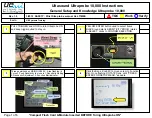
6
VII.
VII.
VII.
VII.
VII. General Guidelines
General Guidelines
General Guidelines
General Guidelines
General Guidelines
•
During measurement always operate electrode with
the fill hole open.
•
Verify protective cap has been removed.
•
During normal use, fill solution will slowly drain out
of the tapered cone junction at the bottom of the
electrode. Excessive loss (>4 cm drop within 24 hours)
is not normal. If this occurs verify the upper cap is
tightened and the interface between the internal cone
and outer body is free of debris.
•
Add fill solution daily to maintain a good head
pressure. For optimum reference response, this level
should be maintained and not be allowed to drop
more than 2-3 cm (1-inch) below fill hole.
•
When changing from one fill solution to another, drain
1st fill solution, rinse with an aliquot of the new
solution, drain, then refill with new fill solution.
•
Components found in the fill solutions should not
interfere with the ion being measured. Verify the correct
solution is being used.
•
Do not use an electrode if crystallized salts are visible
inside the electrode. Drain electrode, disassemble and
rinse internal body with deionized water. Reassemble
and refill with fresh fill solution.
•
If an erratic measurement occurs, check to see if foreign
matter is seen trapped near the internal cone. Drain
and refill with fresh fill solution.
•
The internal chamber of this electrode is gel filled. If
the electrode has been left dry for long periods of time
the gel may be dehydrated giving unstable readings.
Disassemble electrode and soak internal assembly in
HI 7075 fill solution. Verify the ceramic junction is
wetted by the fill solution. Warming the solution
slightly (50
°
C) before soaking it will hasten this
process. Permit the electrode to cool completely while
immersed in this solution.


























